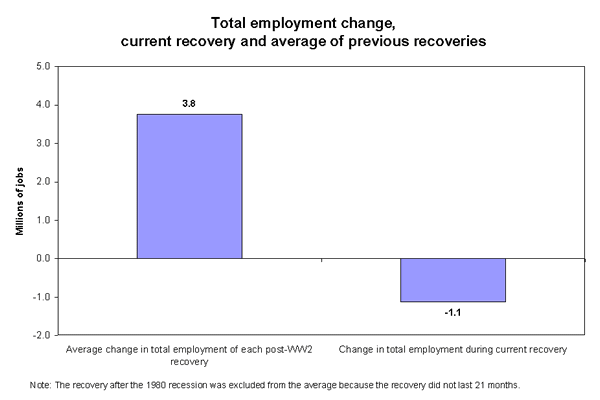September 5, 2003
Despite faster growth, payrolls continue to contract
The nation’s payrolls contracted by 93,000 last month, the seventh month of consecutive job losses and the largest decline since March of this year, according to today’s employment report from the Bureau of Labor Statistics. The unemployment rate fell slightly to 6.1%, but this was driven by a small decline in the labor force and a jump in the number of self-employed persons. Despite some recent positive economic indicators, the labor market remains weak and the nation’s employers are still laying off more workers than they are hiring.
Since the recovery officially began in November 2001, payrolls have fallen by 1.1 million, making this the worst recovery in terms of employment growth since the BLS began tracking monthly data in 1939. Current labor market conditions have been compared to the last jobless recovery in the early 1990s, but by this point—21 months into the new expansion—payrolls in that recovery were up by 876,000.
Over the past year, payrolls have decreased by 463,000, with August marking the 25th consecutive month of year-over-year declines. This is the longest stretch of 12-month declines since the mid-1940s. The figure below illustrates just how anomalous the lack of job growth in this recovery has been. Compared to the 1.1 million jobs lost over this recovery, the average of all past recoveries lasting at least 21 months was a net job gain of 3.8 million.

While manufacturing employment once again contracted sharply in August (-44,000), job losses were spread broadly across industries, with service-producing industries shedding 67,000 jobs. Within services, losses occurred in most subsectors, excluding health care, one area that continues to post strong job growth. The information industry also continues to contract, losing 16,000 jobs in August. Since the recession began in March 2001, IT employment has fallen in all but one month. The IT sector has shed 12% of its jobs since then, comparable to the 14% decline in factory jobs. Local government employment was down by 20,000, with 8,000 of those losses coming from education, suggesting that state budget cuts are starting to be felt at the local level.
Retail trade employment was down slightly, by 3,800, for the fourth consecutive month of losses in that sector. This trend is particularly disappointing given recent positive retail sales reports, implying that stepped-up retail purchases are not leading to new hires (though hours of work among current retail employees have increased in response to the recent demand).
While the above analysis rests on results from the BLS payroll survey of firms, some commentators have noted that the BLS household survey paints a more positive picture of recent employment growth. For example, last month’s household survey shows employment up by 147,000. However, most labor market analysts, including those at the BLS and Congressional Budget Office (CBO), are wary of the household survey’s more positive data and consider the payroll survey more reliable. For example, the BLS commissioner noted today that “the payroll survey provides more reliable information on the current trend in wage and salary employment.” The CBO agrees that the payroll survey “better reflects the state of labor markets,” citing various other sources—such as tax withholding data and unemployment insurance records—which corroborate the payroll trends more so than those of the household survey.
The payroll survey does, however, exclude self-employment, which has been a source of growth lately, up 223,000 last month. This increase more than explains the 147,000 gain in household employment and suggests a loss of 76,000 wage and salary jobs. Thus, neither the payroll survey nor the household survey supports the notion that employers are creating jobs.
Unemployment rates were little changed for most groups, but this in itself is revealing regarding the difficulty facing job seekers. The unemployment rate has been at or above 6.0% since April and above 5.6% since the recovery commenced in November 2001. Unemployment rates by education level underscore the broad-based nature of current labor market distress. Jobless rates for high-school dropouts rose from 8.7% in July to 9.4% in August, and the rate for college-educated workers remained stuck at 3.1% for the fourth consecutive month. In fact, the jobless rate for the college educated has been at or above 3.0% thus far in 2003, their worse trend on record since the BLS began tracking these data in 1994.
This persistently high jobless rate continues to take its toll on wage growth, as hourly wages of production workers in manufacturing and non-managers in services grew 2.9% since last August. Hourly wages have been growing at about this rate for the past year, compared to an average of 3.9% in 2000. Weekly earnings, which also reflect the reduction in hours worked, are growing at 2.0% per year, the lowest growth rate since January 2002 and nearly equal to the rate of inflation. In other words, the persistence of the jobless recovery is leading to slower income growth among working families.
Once again, the monthly employment report presents a stark reminder that the labor market remains weak. Although widely cited reports suggest that economic activity is picking up, employers are not only resisting new hires, they are cutting jobs in almost every industry. Clearly, it will take multiple months of faster growth before the labor market begins to improve.
—Jared Bernstein
with research assistance by Yulia Fungard and Sujan Vasavada
For more information on August job and wage data, go to EPI’s new web feature JobWatch.org.
The Economic Policy Institute JOBS PICTURE is published each month upon release of the Bureau of Labor Statistics’ employment report.